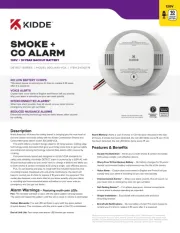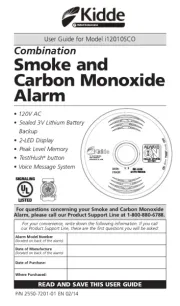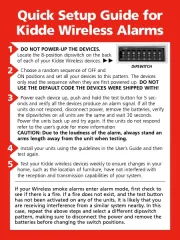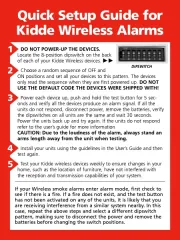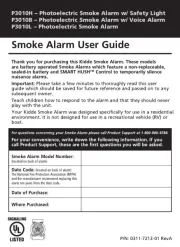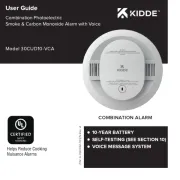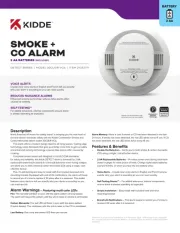
OW TO INSTALL THIS HEAT ALARM
RN OFF POWER TO THE HEAT ALARM CIRCUIT AT THE MAIN DIS
TRIBUTION BOARD BY REMOVING THE FUSE OR SWITCHING THE CIRCUIT BREAKER TO THE O
HIS HEAT ALARM SHOULD BE INSTALLED ONLY BY A QUALIFIED ELECTRICIAN IN ACCOR-
DANCE WITH THE EGULATIONS FOR LECTRICAL NSTALLATIONS PUBLISHED BY THE NSTITUTION OF LECR E I I E -
EGIONAL AND NATIONAL CODES
WARNING: HEAT ALARMS SHOULD BE CONNECTED ON A SINGLE INDEPENDENT,
EDICATED CIRCUIT AT THE MAIN DISTRIBUTION BOARD. NO OTHER ELECTRICAL
EQUIPMENT, EXCEPT COMPATIBLE SMOKE AND CO ALARMS, SHOULD BE CON-
ECTED TO THIS CIRCUIT. IF YOUR HOME HAS RESIDUAL CURRENT DEVICE PRO-
ECTION ON THE ELECTRICAL INSTALLATION OR ON INDIVIDUAL CIRCUITS, CHECK
WITH A QUALIFIED ELECTRICIAN TO MAKE SURE THAT FAULTS ON CIRCUITS SERV-
NG SOCKET OUTLETS OR PORTABLE APPLIANCES CANNOT CAUSE INTERRUPTION
TO THE SUPPLY TO THE HEAT ALARMS.
1. Route the household AC supply/interconnect cable into the dry lining box or
2. Using a suitably-rated terminal block, connect the neutral supply to the blue
lead of the connector plug.
3. Using a suitably-rated terminal block, (supplied with Firex pattresses),connect
the line supply to the brown lead of the connector plug.
4. If interconnecting is desired, connect the orange or white of the connector
plug to the designated interconnect conductor of the household cable. See
note INTERCONNECTING HEAT ALARMS.
NOTE: If this is to be a single-station heat alarm, connect the orange or white
wire to an unused terminal block
5. Insert the completed connector block onto the mounting pins of the Firex Pat-
tress or recess into dry lining box.
6. Pass the connector plug through the mounting plate of the heat alarm, align
slots and fasten mounting plate securely to the Pattress or dry lining box.
N
N
N
N
NO
O
O
O
OT
T
T
T
TE
E
E
E
E:
:
:
:
:
I
I
I
I
If
f
f
f
f
t
t
t
t
th
h
h
h
hi
i
i
i
is
s
s
s
s
i
i
i
i
is
s
s
s
s
t
t
t
t
to
o
o
o
o
b
b
b
b
be
e
e
e
e
a
a
a
a
a
s
s
s
s
si
i
i
i
in
n
n
n
ng
g
g
g
gl
l
l
l
le
e
e
e
e-
-
-
-
-s
s
s
s
st
t
t
t
ta
a
a
a
at
t
t
t
ti
i
i
i
io
o
o
o
on
n
n
n
n
h
h
h
h
he
e
e
e
ea
a
a
a
at
t
t
t
t
a
a
a
a
al
l
l
l
la
a
a
a
ar
r
r
r
rm
m
m
m
m,
,
,
,
,
c
c
c
c
co
o
o
o
on
n
n
n
nn
n
n
n
ne
e
e
e
ec
c
c
c
ct
t
t
t
t
t
t
t
t
th
h
h
h
he
e
e
e
e
o
o
o
o
or
r
r
r
ra
a
a
a
an
n
n
n
ng
g
g
g
ge
e
e
e
e
o
o
o
o
or
r
r
r
r
w
w
w
w
wh
h
h
h
hi
i
i
i
it
t
t
t
te
e
e
e
e
w
w
w
w
wi
i
i
i
ir
r
r
r
re
e
e
e
e
t
t
t
t
to
o
o
o
o
a
a
a
a
an
n
n
n
n
u
u
u
u
un
n
n
n
nu
u
u
u
us
s
s
s
se
e
e
e
ed
d
d
d
d
t
t
t
t
te
e
e
e
er
r
r
r
rm
m
m
m
mi
i
i
i
in
n
n
n
na
a
a
a
al
l
l
l
l
b
b
b
b
bl
l
l
l
lo
o
o
o
oc
c
c
c
ck
k
k
k
k.
.
.
.
.
7. Attach connector plug to pins on back of heat alarm. Plug will only fit one way
and will snap into place.
8. Gently tug connector to be sure it is attached securely.
N
N
N
N
NO
O
O
O
OT
T
T
T
TE
E
E
E
E:
:
:
:
:
S
S
S
S
St
t
t
t
te
e
e
e
ep
p
p
p
ps
s
s
s
s
9
9
9
9
9
a
a
a
a
an
n
n
n
nd
d
d
d
d
1
1
1
1
10
0
0
0
0
f
f
f
f
fo
o
o
o
or
r
r
r
r
M
M
M
M
Mo
o
o
o
od
d
d
d
de
e
e
e
el
l
l
l
ls
s
s
s
s
K
K
K
K
KF
F
F
F
F3
3
3
3
30
0
0
0
0,
,
,
,
,
K
K
K
K
KF
F
F
F
F3
3
3
3
30
0
0
0
0L
L
L
L
LL
L
L
L
L
o
o
o
o
on
n
n
n
nl
l
l
l
ly
y
y
y
y.
.
.
.
.
T
T
T
T
Th
h
h
h
he
e
e
e
es
s
s
s
se
e
e
e
e
m
m
m
m
mo
o
o
o
od
d
d
d
de
e
e
e
el
l
l
l
ls
s
s
s
s
c
c
c
c
co
o
o
o
on
n
n
n
nt
t
t
t
ta
a
a
a
ai
i
i
i
in
n
n
n
n
a
a
a
a
a
b
b
b
b
ba
a
a
a
at
t
t
t
tt
t
t
t
te
e
e
e
er
r
r
r
ry
y
y
y
y
p
p
p
p
pu
u
u
u
ul
l
l
l
ll
l
l
l
l
t
t
t
t
ta
a
a
a
ab
b
b
b
b
f
f
f
f
fo
o
o
o
or
r
r
r
r
y
y
y
y
yo
o
o
o
ou
u
u
u
ur
r
r
r
r
c
c
c
c
co
o
o
o
on
n
n
n
nv
v
v
v
ve
e
e
e
en
n
n
n
ni
i
i
i
ie
e
e
e
en
n
n
n
nc
c
c
c
ce
e
e
e
e.
.
.
.
.
B
B
B
B
Ba
a
a
a
at
t
t
t
tt
t
t
t
te
e
e
e
er
r
r
r
ry
y
y
y
y
p
p
p
p
pu
u
u
u
ul
l
l
l
ll
l
l
l
l
t
t
t
t
ta
a
a
a
ab
b
b
b
b
m
m
m
m
mu
u
u
u
us
s
s
s
st
t
t
t
t
b
b
b
b
be
e
e
e
e
r
r
r
r
re
e
e
e
em
m
m
m
mo
o
o
o
ov
v
v
v
ve
e
e
e
ed
d
d
d
d
t
t
t
t
to
o
o
o
o
a
a
a
a
ac
c
c
c
ct
t
t
t
ti
i
i
i
iv
v
v
v
va
a
a
a
at
t
t
t
te
e
e
e
e
b
b
b
b
ba
a
a
a
at
t
t
t
tt
t
t
t
te
e
e
e
er
r
r
r
ry
y
y
y
y
b
b
b
b
ba
a
a
a
ac
c
c
c
ck
k
k
k
ku
u
u
u
up
p
p
p
p
a
a
a
a
an
n
n
n
nd
d
d
d
d
p
p
p
p
pr
r
r
r
ro
o
o
o
ov
v
v
v
vi
i
i
i
id
d
d
d
de
e
e
e
e
p
p
p
p
po
o
o
o
ow
w
w
w
we
e
e
e
er
r
r
r
r
t
t
t
t
to
o
o
o
o
t
t
t
t
th
h
h
h
he
e
e
e
e
u
u
u
u
un
n
n
n
ni
i
i
i
it
t
t
t
t
i
i
i
i
in
n
n
n
n
t
t
t
t
th
h
h
h
he
e
e
e
e
e
e
e
e
ev
v
v
v
ve
e
e
e
en
n
n
n
nt
t
t
t
t
o
o
o
o
of
f
f
f
f
m
m
m
m
ma
a
a
a
ai
i
i
i
in
n
n
n
ns
s
s
s
s
p
p
p
p
po
o
o
o
ow
w
w
w
we
e
e
e
er
r
r
r
r
l
l
l
l
lo
o
o
o
os
s
s
s
ss
s
s
s
s.
.
.
.
.
9. Pull out the battery pull tab. Heat alarm may beep briefly when battery is acti-
10. Push button and hold button on front cover of heat alarm for five (5) seconds.
Heat alarm should sound its alarm horn if battery is connected. NOTE: cover
sounder vents with your hand or hold unit at arm's length during testing to
11. Position heat alarm to mounting plate and turn it clockwise to lock into place.
H
H
H
H
He
e
e
e
ea
a
a
a
at
t
t
t
t
a
a
a
a
al
l
l
l
la
a
a
a
ar
r
r
r
rm
m
m
m
m
w
w
w
w
wi
i
i
i
il
l
l
l
ll
l
l
l
l
n
n
n
n
no
o
o
o
ot
t
t
t
t
m
m
m
m
mo
o
o
o
ou
u
u
u
un
n
n
n
nt
t
t
t
t
t
t
t
t
to
o
o
o
o
p
p
p
p
pl
l
l
l
la
a
a
a
at
t
t
t
te
e
e
e
e
i
i
i
i
if
f
f
f
f
b
b
b
b
ba
a
a
a
at
t
t
t
tt
t
t
t
te
e
e
e
er
r
r
r
ry
y
y
y
y
i
i
i
i
is
s
s
s
s
n
n
n
n
no
o
o
o
ot
t
t
t
t
i
i
i
i
in
n
n
n
ns
s
s
s
st
t
t
t
ta
a
a
a
al
l
l
l
ll
l
l
l
le
e
e
e
ed
d
d
d
d
(
(
(
(
(M
M
M
M
Mo
o
o
o
od
d
d
d
de
e
e
e
el
l
l
l
ls
s
s
s
s
K
K
K
K
KF
F
F
F
F3
3
3
3
30
0
0
0
0,
,
,
,
,
K
K
K
K
KF
F
F
F
F3
3
3
3
30
0
0
0
0L
L
L
L
LL
L
L
L
L
o
o
o
o
on
n
n
n
nl
l
l
l
ly
y
y
y
y)
)
)
)
).
.
.
.
.
12. Turn on power at main fuse box or circuit breaker. The green LED on the cover
13. Test heat alarm. See "TESTING THE HEAT ALARM".
Heat alarms give an audible warning when the temperature at the alarm reaches
57°C. Heat alarms are ideal for kitchens, garages, cellars, boiler rooms, attics and
other areas where there are normally high levels of fumes, smoke or dust which pre-
clude the use of smoke alarms due to the risk of false alarms.
Guidance on fire detection in dwellings is contained in BS 5839: Part 6. For normal-
sized bungalows, two-story houses, flats and maisonettes, the British Standard rec-
ommends that the minimum level of protection should comprise smoke alarms in the
hallways and staircases. This minimum standard necessitates one smoke alarm in the
hallway of a typical bungalow or one smoke alarm on each level of a two-story house.
Heat alarms should not be used in these circulation areas. If there are, for example,
long hallways, even the minimum standard may necessitate additional interconnected
If, however, the design of the dwelling does not comply with modern fire safety stan-
dards, or if factors such as the presence of several young children, or elderly occu-
pants or disabled people, or of smokers, the use of portable heaters or solid fuel fires
during the night, or the use of electric blankets, particularly by the elderly, the British
Standard advises that additional detection devices, installed within rooms, may be
The British Standard recommends that, if the risk justifies the provision of detectors in
a kitchen, boiler room, or other area (except a circulation area) in which smoke
alarms would be likely to give false alarms, heat alarms should be used. However, the
Standard also advises that heat alarms may be installed in other rooms instead of
smoke alarms, provided that the construction enclosing the room (including the door)
can resist fire for a sufficient time after operation of a heat alarm to enable occupants
to escape safely. However, a heat alarm is unlikely to operate early enough to save
the life of anyone asleep in the room in which it is installed. Moreover, a heat alarm in
the room of fire origin may not give sufficient warning for occupants to escape safely
if the door to that room is open. A Heat Alarm is also recommended in the Living
Room, if a smoke alarm in that location, suffers nuisance alarms from smokers.
F
F
F
F
FO
O
O
O
OR
R
R
R
R
B
B
B
B
BE
E
E
E
ES
S
S
S
ST
T
T
T
T
P
P
P
P
PR
R
R
R
RO
O
O
O
OT
T
T
T
TE
E
E
E
EC
C
C
C
CT
T
T
T
TI
I
I
I
IO
O
O
O
ON
N
N
N
N,
,
,
,
,
I
I
I
I
IT
T
T
T
T
I
I
I
I
IS
S
S
S
S
R
R
R
R
RE
E
E
E
EC
C
C
C
CO
O
O
O
OM
M
M
M
MM
M
M
M
ME
E
E
E
EN
N
N
N
ND
D
D
D
DE
E
E
E
ED
D
D
D
D
T
T
T
T
TH
H
H
H
HA
A
A
A
AT
T
T
T
T
Y
Y
Y
Y
YO
O
O
O
OU
U
U
U
U
I
I
I
I
IN
N
N
N
NS
S
S
S
ST
T
T
T
TA
A
A
A
AL
L
L
L
LL
L
L
L
L
A
A
A
A
A
S
S
S
S
SM
M
M
M
MO
O
O
O
OK
K
K
K
KE
E
E
E
E
O
O
O
O
OR
R
R
R
R
H
H
H
H
HE
E
E
E
EA
A
A
A
AT
T
T
T
T
A
A
A
A
AL
L
L
L
LA
A
A
A
AR
R
R
R
RM
M
M
M
M
I
I
I
I
IN
N
N
N
N
E
E
E
E
EV
V
V
V
VE
E
E
E
ER
R
R
R
RY
Y
Y
Y
Y
R
R
R
R
RO
O
O
O
OO
O
O
O
OM
M
M
M
M.
.
.
.
.
In addition, it is recommended that all smoke and
heat alarms should be interconnected.
Install heat alarm on a standard dry lining box or Firex pattress as close to the centre of
the ceiling as possible. If the centre is not practical, mount the heat alarm no closer
than 300mm away from a wall or corner.
In rooms with open joists or beams, all ceiling-mounted alarms should be located
on the bottom of such joists or beams and not up in joist channels. On sloped,
peaked or gabled ceilings, install heat alarm 90cm from highest point. If only wall
placement is possible, install no further than 150mm from ceiling.
D
D
D
D
DO
O
O
O
O
N
N
N
N
NO
O
O
O
OT
T
T
T
T
i
i
i
i
in
n
n
n
ns
s
s
s
st
t
t
t
ta
a
a
a
al
l
l
l
ll
l
l
l
l
h
h
h
h
he
e
e
e
ea
a
a
a
at
t
t
t
t
a
a
a
a
al
l
l
l
la
a
a
a
ar
r
r
r
rm
m
m
m
ms
s
s
s
s:
:
:
:
:
• Directly over the cooker, stove or oven.
• In areas with high humidity, like bathrooms or shower rooms, or areas near
dishwashers or washing machines. Install heat alarms at least 3m away from
• Adjacent to, or directly above, heaters, air-conditioning vents or ceiling fans.
• In an area where the temperature may fall below -30°C or rise above 37°C.
• In areas above 93% relative humidity (RH), non-condensing.
• Near fluorescent lights. Electrical noise and flickering may affect the
operation of the heat alarm.
• Closer than 300mm to light fittings.
• In such a position that it is difficult or dangerous to reach for testing or main-
• Do not site the alarm in an area where water or other liquids may enter the alarm.
DC BACK UP (KF30: 9V REPLACEABLE,
NTERCONNECTING IREXFUP TO ANY COMBINATION OF 2
S HMOKE AND EAT LARMSAMODELS,
KF1, KF1R, KF2, KF2R, KF3, KF3R,
OR PATTRESS WITH ELAYR ) 4870, 4881, 4973, 4985, 4892, 4899,1SFW, 1SFWR,
KF10, KF10LL, KF10R, KF20, KF20LL, KF20R, KF30,
OPERATES UP TO HUMIDITY NON CONDENSING93% ( - )
MAXIMUM ISTANCE FROMD WALL 7
IMPORTANT SAFETY INFORMATION
PLEASE READ AND SAVE THESE INSTRUCTIONS
• The KF30R requires constant 230V AC power AND fully charged batteries to
operate properly. It requires 2 full days under mains power to reachfull back
up capacity. The batteries are not replaceable. Do not connect heat alarm to
any other type of device except those listed in this user guide.
• The KF30 and KF30LL heat alarm requires constant 230V AC power AND a
healthy 9V DC battery to operate properly. Removal of battery and loss or dis-
connection of AC power will render the alarm inoperative. DO NOT use any
other kind of battery except as specified in this user guide. Do not connect
heat alarm to any other type of device except those listed in this user guide.
• The TEST/FALSE ALARM CONTROL button accurately tests all heat alarmfunc-
tions. DO NOT use any other test method for routine testing. Test heat alarm
weekly to ensure proper operation.
• Higher ceilings will increase the time needed by the heat alarm to detect a
fire. In most dwellings the ceiling height will keep this reaction time within
acceptable limits. However, ceilings with a height of over 6m may delay the
reaction time of the heat alarm significantly. Advice from your local distribu-
tor or Fire Brigade should be obtained when installing a heat alarm on a ceil-
• This heat alarm should be installed only by a qualified electrician. The installa-
tion should comply with BS 7671 and all prevailing local, regional and national
• This heat alarm is designed to be used only as part of the protection of a sin-
gle family dwelling or a house in multiple occupation (HMO) of no more than
two stories. It also may be used in conjunction with smoke alarms within indi-
vidual flats or apartments in larger houses in multiple occupation, to provide
an early warning to occupants of a fire in a room within the dwelling, but a
communal fire alarm system also should be provided in such cases. DO NOT
install this heat alarm in any other buildings, such as hotels, motels, dormito-
ries, hospitals, nursing homes or group homes of any kind. In these occupan-
cies, a complete automatic fire detection and alarm system, complying with
BS 5839: Part 1, should be installed.
• Heat alarms should be used only in conjunction with smoke alarms, with
which the heat alarms should be interconnected, in order to provide early
warning of heat, smoke, or fire. Smoke alarms should be installed on every
• Interconnected heat alarms and smoke alarms offer maximum protection. By
interconnecting heat alarms and smoke alarms, when one unit senses heat,
smoke, or fire, and sounds its alarm, all others will sound as well. DO NOT
connect this heat alarm to any other type of alarm except those stated in this
user guide or an approved auxiliary device.
• Heat alarms interconnected with smoke alarms may not alert every household
member every time. The alarm sounder of the heat alarm is loud in order to
alert individuals of a potential danger. However, there may be limiting circum-
stances where an occupant may not hear the alarm (e.g., outdoor or indoor
noise, sound sleepers, drug or alcohol usage, impaired hearing, etc.). House-
hold members must hear the alarm’s warning sound and quickly respond to it
to reduce the risk of damage, injury, or death that may result from fire.
• Check carefully that, when any one device operates, the alarm signal given by
interconnected devices is clearly audible throughout the building, particularly
in bedrooms, where it is essential that the alarm signal will wake sleeping oc-
• This heat alarm can sound an alarm only when it detects temperatures of 57°C
or above. Heat alarms do not sense smoke or gas. In some fires, hazardous
levels of toxic chemicals and smoke can build up before a heat alarm will op-
erate. Temperatures may not reach 57°C to activate the heat alarm QUICKLY
ENOUGH to ensure safe escape.
• Some fires are slow smouldering, low heat-producing, or are in a different
room to that in which the heat alarm is located, or the heat from the fire may
bypass the alarm – the heat alarm may not give a warning under these cir-
• HEAT ALARMS HAVE LIMITATIONS. This heat alarm is not guaranteed to protect
lives or property. Heat alarms are not a substitute for insurance. Householders
should insure their lives and property. In addition, as with any electronic device,
it is possible for the heat alarm to fail at any time.
• Never paint this heat alarm.
• This heat alarm is powered from a 230V AC supply, and has a DC battery back-up
source. AC/DC heat alarms offer added protection in the event of a power failure.
• Unique power connector prevents interconnecting with incompatible heat alarms,
CO alarms, smoke alarms, or security systems.
• Items KF30, KF30LL and KF30R heat alarms can be interconnected with up to 23
other models as shown in the Specifications. Do not connect to any other type or
model of smoke, CO, or heat alarm.
• Hush quiets unwanted alarms for up to 9 minutes.
• KF30R includes permanent rechargeable lithium batteries.
• Alarm memory identifies which alarm has activated
• Optional use tamper-resistant feature serves as a safeguard against tampering.
• The heat alarm will sound a short beep about once every 40 seconds if the battery
• Multi-purpose green and red LEDs indicate that the heat alarm is connected to the
AC supply, is working normally, or is in alarm.
• Loud alarm sounder – 85 decibels [dB(A)] at 3m – will sound to alert you to an
• Test button checks heat alarm operation.
• KF30LL is provided with a long life lithium battery that lasts the full life of the alarm
and a tamper-proof option using screw provided
ITEM (MODEL NUMBER) KF30, KF30LL, KF30R
KF30LL SEALED-IN LITHIUM BATTERY
LEASE READ AND SAVE THIS USER GUIDE
nstaller: Please leave this user guide with
the occupier (or, in the case of a house
in multiple operation, with the owner).
p.2 Important Safety Information
p.4 How to Install This Heat Alarm
p.5 Interconnecting Heat Alarms
p.5 Red and Green LED Indicators
p.5 Testing the Heat Alarm
p.6 Maintenance, Cleaning,and Battery replacement-KF30 only
p.7 Fire Safety Rules and Preventing Hazardous Situations
p.7 What to Do in Case of Fire
INTERLINK
NEUTRAL
BROWN
ORANGE OR WHITE
BLUE
INTERLINK
NEUTRAL
BROWN
ORANGE OR WHITE
BLUE
tandard Dry Lining box or Firex pattress
Standard Dry Lining box or Firex pattress
WARNING: HEAT ALARMS ALONE ARE NOT SUFFICIENT FOR LIFE SAFETY AS THEY ARE NOT DESIGNED TO DE-
TECT SMOKE HEY ARE INTENDED TO DETECT TEMPERATURES OF AND ABOVE TO PROVIDE AN ADDI. T 57°C -
TIONAL SOURCE OF INFORMATION THAT IS SUPPLEMENTARY TO THAT PROVIDED BY SMOKE ALARMS TO
INCREASE THE PROBABILITY THAT AN EARLY WARNING WILL BE PROVIDED AND SO ENHANCE LIFE SAFETY AND
. SEE HEAT ALARMS HAVE LIMITATIONS IN THE IMPORTANT SAFETY
SECTION OF THIS USER GUIDE.
N
N
N
N
NO
O
O
O
OT
T
T
T
TE
E
E
E
E:
:
:
:
:
Additional markings can be found on the
1003-7203-03_(KF30_KF30LL_KF30R)_KM738879:_ 2021.6.10 3:31 PM Page 1
